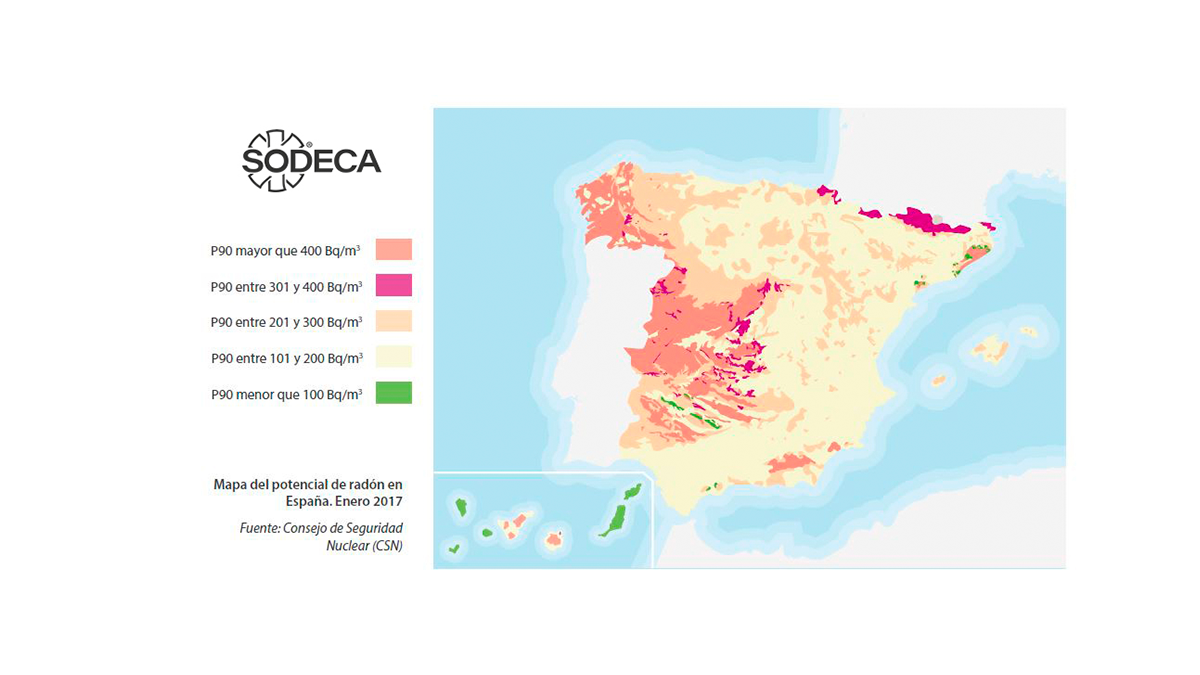Radon is a radioactive pollutant of natural origin that arises from the decay of uranium. This decay results in the emission of high-energy alpha particles, which can damage our DNA and cause mutations and tumors. Radon tends to concentrate in underground and low-lying spaces and can reach us through infiltration from granite soils (typically) and, to a lesser extent, from its presence in water and some construction materials.
The World Health Organization (WHO) estimates that up to 14% of lung cancer cases worldwide are attributable to radon gas exposure, making it the second leading cause of lung cancer after tobacco. Additionally, the WHO estimates that the chances of a person developing this type of cancer increase tenfold if they are also a smoker.
In Spain, the Ministry of Health estimates that radon gas exposure is responsible for 4% of lung cancer deaths, reaching up to 25% in some regions like Galicia.
Reference Regulations
In Spain, protection measures against radon have been included since 2019 in the Basic Health Document HS 6 of the Technical Building Code (CTE). This regulation applies to habitable spaces in newly constructed residential buildings and all interventions in existing buildings. It sets a reference level for the annual average indoor radon concentration at 300 Bq/m³. Additionally, it classifies municipalities based on their potential risk for high radon concentrations. In these areas, it mandates the implementation of mitigation solutions such as protective barriers, ventilated containment spaces, and/or ground depressurization systems.
Furthermore, Royal Decree 1029/2022 establishes regulations on health protection against the risks from exposure to ionizing radiation, summarizing workplace requirements for radon exposure protection.
This regulation requires the estimation of the annual average radon concentration in underground workplaces, in places where groundwater is processed, handled, or utilized, and in all workplaces located below ground level or on the ground floor in priority action municipalities.
When radon concentrations in the air exceed the reference level of 300 Bq/m³ in any workplace area, the activity owner must take appropriate measures to reduce concentrations and/or exposure to radon.
Fulfilling one of the main objectives of this Royal Decree, the National Plan against Radon was presented in early 2024. This plan outlines the strategies and activities to be carried out by various public administrations to reduce the health risk from radon exposure. It provides basic information about radon and its health risks and presents an analysis of the situation in Spain, including available information on exposure.
Radon Mitigation Strategies
There are currently different protection solutions against radon, generally focused on radon from the ground. Their main objective is to reduce people's exposure to radon indoors. These solutions can generally be grouped into:
Isolation Solutions:
- Protective Barriers: These are designed to prevent radon from entering buildings by improving the seal of the building envelope in contact with the ground.
Ventilation Solutions:
- Containment Space Ventilation: The containment space, air chamber, or sanitary chamber is a space between the ground and the protected rooms. It is where most of the radon from the ground tends to accumulate. Ventilating the air chamber as a containment space aims to reduce the radon concentration that the enclosures of habitable rooms are exposed to by expelling radon-rich air from the chamber and preventing it from entering habitable spaces.
- Ground Depressurization: This aims to reduce the radon concentration that can penetrate the building's enclosures by creating a depression in the ground beneath or adjacent to the building using a mechanical extractor, promoting the expulsion of radon to the outside and preventing it from entering the building.
- Ventilation of Habitable Spaces: This aims to reduce the indoor radon concentration by increasing air exchange in indoor spaces, diluting radon concentration with a sufficient amount of clean air.
In interventions in existing buildings, isolation solutions often face limitations due to the presence of pre-existing construction elements, the scope of the intervention, and available economic resources. Therefore, ventilation solutions are often the only alternative.
Ventilation-based solutions often require continuously operating equipment, which should be considered when selecting systems that maximize energy efficiency without compromising user health. Therefore, selected solutions for ventilation strategies in containment spaces or ground depressurization should feature EC motorization, providing more precise regulation and lower energy consumption.
Additionally, ventilation solutions for habitable spaces should always incorporate heat recovery units capable of filtering and renewing indoor air while recovering part of the energy used in heating and cooling operations.
